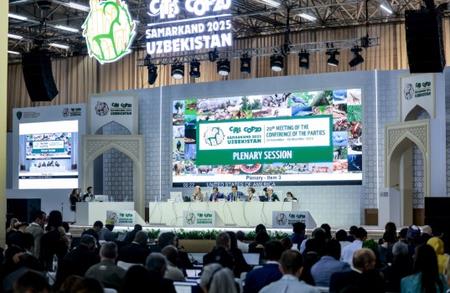
Delegates To Decide On Global Wildlife Trade Rules As CITES Cop20 Opens In Samarkand
Hosted by the National Committee on Ecology and Climate Change of the Republic of Uzbekistan, the opening ceremony featured vibrant traditional Uzbek music and dance performances. The segment underscored its pride in hosting this landmark event, bringing to life the official slogan of the meeting,“CITES at 50 in Samarkand: Bridging Nature and People”.
In his opening remarks, Aziz Abdukhakimov, Advisor to the President of Uzbekistan, Chair of the National Committee on Ecology and Climate Change and CITES CoP20 President, emphasized Uzbekistan's prioritization of the sustainable use of wildlife resources, stating:“The declaration of 2025 as the 'Year of Environmental Protection and the Green Economy in Uzbekistan' reflects our strategic commitment to environmental sustainability and to transitioning to a green, resource-efficient development model... Uzbekistan is confidently emerging as one of the leading countries in the region and globally in addressing environmental challenges.”
CITES Secretary-General Ivonne Higuero followed with an invitation to the nearly 3,000 participants to join her in celebrating 50 years since the Convention entered into force, remarking:“Samarkand, a city that for centuries stood as a crossroads of cultures, ideas, and trade, is a symbol of connection, dialogue, and cooperation, the very values that define CITES. We also celebrate five decades of tireless work by parties to ensure that international trade in wild animals and plants does not threaten their survival. That principle is as relevant today as it was in 1975, perhaps even more so.”
The Secretary-General also announced the Winners and Finalists of the CITES 50th Anniversary Photo Contest, whose photographs were submitted under four categories that called on the CITES global community of photographers to capture the essence of the Convention's wild species of animals and plants, people, partnerships and youth perspectives.
The meeting moved swiftly through several foundational agenda items in preparation for the intensive negotiations to follow. Parties elected the Chair, Alternate Chair, and Vice-Chairs of the meeting, establishing the leadership that will guide the proceedings. They then adopted the agenda and Working Programme, setting the roadmap for the two weeks of discussion.
The plenary also reviewed and adopted the Rules of Procedure, laying out the framework for how decisions will be taken. It then proceeded to the admission of observers, ensuring broad and inclusive participation in the deliberations.
Attention then turned to reports from the Standing Committee, the Animals Committee and the Plants Committee. Delegates also considered proposals aimed at addressing the workload and enhancing the efficiency of the convention by establishing a process under the permanent committees, an issue of growing importance as the scope of CITES continues to expand.
Following the plenary discussions, delegations convened for regional meetings to agree on regional representation in the Standing Committee, laying the groundwork for coordination and consensus-building within and across regions as negotiations move forward.
With these initial procedural steps completed, CoP20 now begins the substantive phase of its work. Over the next two weeks, parties will consider proposals to amend the CITES Appendices, examine the conservation status of a wide array of species, and review measures designed to enhance compliance, strengthen enforcement cooperation and advance the implementation of the CITES Strategic Vision 2030.
Discussions will also touch on the sustainability of trade in key terrestrial and aquatic species, alongside efforts to reinforce reporting systems, improve national legislation, and address the gaps that threaten conservation outcomes.
With a shared sense of purpose filling the halls of the Silk Road Samarkand Expo Centre, CoP20 has begun with the collective resolve to forge a more sustainable future for the world's natural heritage.
The decisions made here will reinforce global commitments to supporting the Kunming-Montreal Global Biodiversity Framework (KMGBF) and the 2030 Agenda for Sustainable Development, and to bridging nature and people for generations to come.

Legal Disclaimer:
MENAFN provides the
information “as is” without warranty of any kind. We do not accept
any responsibility or liability for the accuracy, content, images,
videos, licenses, completeness, legality, or reliability of the information
contained in this article. If you have any complaints or copyright
issues related to this article, kindly contact the provider above.

















Comments
No comment